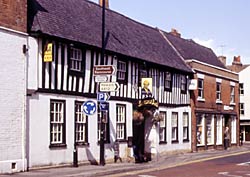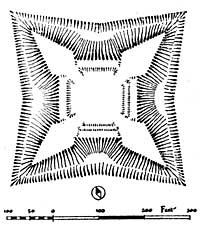
Structual
Standing buildings
Nottingham Castle: the site of the parliamentarian garrison throughout the war, although the main structure was constructed later the site, the grounds and the extensive archaeological work and displays give a sense of the place in the war. The castle was under the command of Colonel John Hutchinson.
Newark Castle: The royalist ‘capital’ for the county: it was here that the king stayed in 1645.
St Mary Magdelene, Newark: the church tower bears the scars of war – cannon ball damage from the three sieges of Newark (1643, 1644 and 1645-6). It was also where the funeral services for those who died during he sieges were held.
The Governor’s House, Newark: this building was where the governors of the town lived and worked Colonel Sir John Henderson 1642-3, Colonel Sir Richard Byron, 1643-4, Colonel Sir Richard Willys 1644-5 and Colonel John Lord Belasyse, 1645-6.
 |
The Saracen's Head. Southwell (photo: Martyn Bennett). |
Saracen’s Head, Southwell: In 1646 this was the king’s head. Charles I in disguise rode herein May 1646 and made overtures to the Scots forces besieging Newark. He wanted to surrender to the Earl of Leven and try and drive a wedge between the Scottish and their English and Welsh allies. Leven wisely informed the English commander of the king’s arrival.
Shelford Church: Shelford Hall was one of Newark’s satellite garrisons, and the scene of a massacre in November 1645 when the besiegers killed most of the defenders at the storming of the hall and church.
Wiverton Hall Gateway: Wiverton hall was another of Newark’s satellite garrisons and the gateway is the remains of the hall that was at that time fortified. There is also the remains of a battery and ditch in the grounds of the hall.
Welbeck Abbey: Welbeck was the home of the royalist grandee commander the Earl and later Marquis of Newcastle. It was garrisoned at the outbreak of war, although little fighting occurred in the vicinity until it was surrendered after the Battle of Marston Moor (2July 1644) Welbeck was briefly garrisoned by royalists again from August to November 1645.
Colonel John Hutchinson’s Memorial at Owthorpe: designed by his wife and biographer Lucy Hutchinson.
 |
Plan of the Queen's Sconce, Newark. |
Ruins & earthworks
The Queen’s Sconce, Newark: The most impressive of the remaining earthworks, this 3-acre structure was built in 1644 to guard the southern approaches to the garrison. The matching King’s Sconce was demolished in 1887.
Archaeological remains: At Newark: Ramparts, Friary Road; Royalist fort, Muskham Bridge; Raised battery and other works at Crankley Lane; Millgate defences; Scots redoubt; sconce at Stoke Lodge and Sandhills Sconce on Tolney Lane. At Hawton: redoubt.